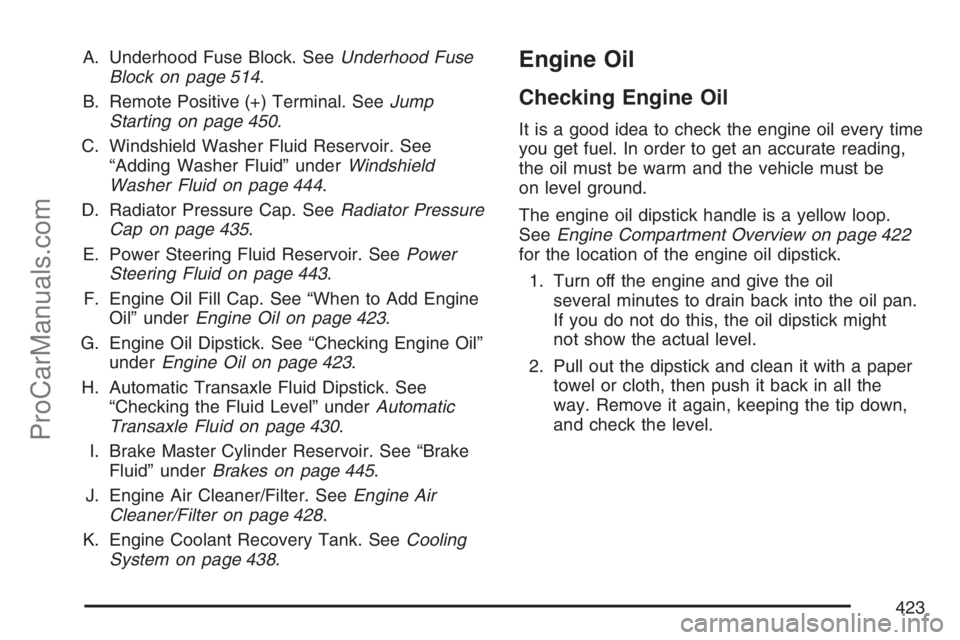coolant reservoir SATURN RELAY 2007 Owners Manual
[x] Cancel search | Manufacturer: SATURN, Model Year: 2007, Model line: RELAY, Model: SATURN RELAY 2007Pages: 570, PDF Size: 3.41 MB
Page 423 of 570

A. Underhood Fuse Block. SeeUnderhood Fuse
Block on page 514.
B. Remote Positive (+) Terminal. SeeJump
Starting on page 450.
C. Windshield Washer Fluid Reservoir. See
“Adding Washer Fluid” underWindshield
Washer Fluid on page 444.
D. Radiator Pressure Cap. SeeRadiator Pressure
Cap on page 435.
E. Power Steering Fluid Reservoir. SeePower
Steering Fluid on page 443.
F. Engine Oil Fill Cap. See “When to Add Engine
Oil” underEngine Oil on page 423.
G. Engine Oil Dipstick. See “Checking Engine Oil”
underEngine Oil on page 423.
H. Automatic Transaxle Fluid Dipstick. See
“Checking the Fluid Level” underAutomatic
Transaxle Fluid on page 430.
I. Brake Master Cylinder Reservoir. See “Brake
Fluid” underBrakes on page 445.
J. Engine Air Cleaner/Filter. SeeEngine Air
Cleaner/Filter on page 428.
K. Engine Coolant Recovery Tank. SeeCooling
System on page 438.Engine Oil
Checking Engine Oil
It is a good idea to check the engine oil every time
you get fuel. In order to get an accurate reading,
the oil must be warm and the vehicle must be
on level ground.
The engine oil dipstick handle is a yellow loop.
SeeEngine Compartment Overview on page 422
for the location of the engine oil dipstick.
1. Turn off the engine and give the oil
several minutes to drain back into the oil pan.
If you do not do this, the oil dipstick might
not show the actual level.
2. Pull out the dipstick and clean it with a paper
towel or cloth, then push it back in all the
way. Remove it again, keeping the tip down,
and check the level.
423
ProCarManuals.com
Page 443 of 570

7. Then replace the pressure cap. At any time
during this procedure if coolant begins to �ow
out of the �ller neck, reinstall the pressure cap.
Be sure the pressure cap is closed properly.
8. Then �ll the coolant recovery tank to the full
cold mark.
9. Put the cap back on the coolant recovery tank.Power Steering Fluid
The power steering �uid
reservoir is located
toward the rear of the
engine compartment on
the passenger’s side
of the vehicle. See
Engine Compartment
Overview on page 422
for reservoir location.
When to Check Power Steering Fluid
It is not necessary to regularly check power
steering �uid unless you suspect there is a leak
in the system or you hear an unusual noise.
A �uid loss in this system could indicate a problem.
Have the system inspected and repaired.
Filling the Coolant Recovery Tank
443
ProCarManuals.com
Page 445 of 570

Notice:
When using concentrated washer �uid,
follow the manufacturer’s instructions
for adding water.
Do not mix water with ready-to-use washer
�uid. Water can cause the solution to
freeze and damage your washer �uid tank
and other parts of the washer system.
Also, water does not clean as well
as washer �uid.
Fill your washer �uid tank only
three-quarters full when it is very cold.
This allows for expansion if freezing
occurs, which could damage the tank if
it is completely full.
Do not use engine coolant (antifreeze) in
your windshield washer. It can damage
your washer system and paint.
Brakes
Brake Fluid
Your brake master
cylinder reservoir is
�lled with DOT-3 brake
�uid. SeeEngine
Compartment Overview
on page 422for the
location of the reservoir.
There are only two reasons why the brake �uid
level in the reservoir might go down. The �rst
is that the brake �uid goes down to an acceptable
level during normal brake lining wear. When
new linings are put in, the �uid level goes back
up. The other reason is that �uid is leaking out of
the brake system. If it is, you should have your
brake system �xed, since a leak means that
sooner or later your brakes will not work well,
or will not work at all.
445
ProCarManuals.com
Page 527 of 570

At Each Fuel Fill
It is important to perform these underhood checks
at each fuel �ll.
Engine Oil Level Check
Check the engine oil level and add the proper oil
if necessary. SeeEngine Oil on page 423for
further details.
Notice:It is important to check your oil
regularly and keep it at the proper level. Failure
to keep your engine oil at the proper level
can cause damage to your engine not covered
by your warranty.
Engine Coolant Level Check
Check the engine coolant level and add
DEX-COOL®coolant mixture if necessary. See
Engine Coolant on page 432for further details.
Windshield Washer Fluid Level Check
Check the windshield washer �uid level in
the windshield washer �uid reservoir and add
the proper �uid if necessary.
At Least Once a Month
Tire In�ation Check
Visually inspect your vehicle’s tires and make
sure they are in�ated to the correct pressures.
Do not forget to check the spare tire. See
In�ation - Tire Pressure on page 469. Check to
make sure the spare tire is stored securely.
SeeChanging a Flat Tire on page 484.
Tire Wear Inspection
Tire rotation may be required for high mileage
highway drivers prior to the Engine Oil Life System
service noti�cation. Check the tires for wear
and, if necessary, rotate the tires. SeeTire
Inspection and Rotation on page 472.
527
ProCarManuals.com